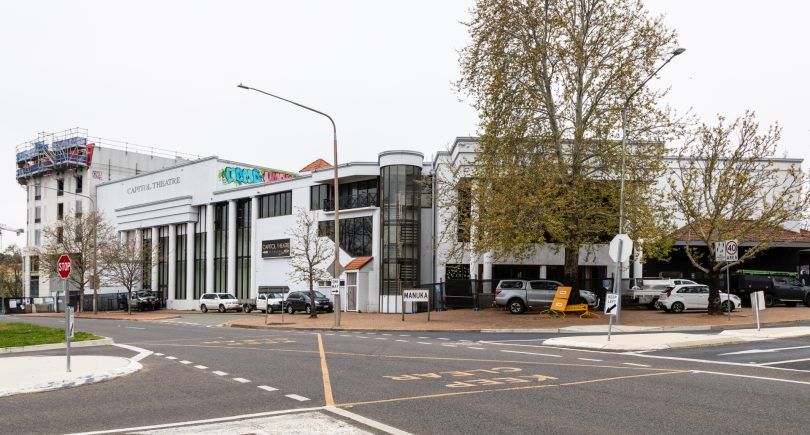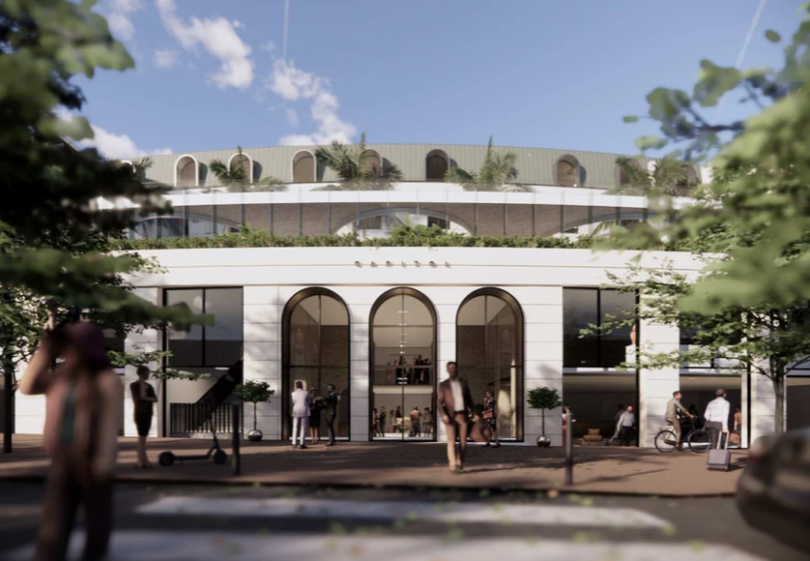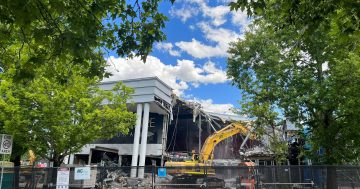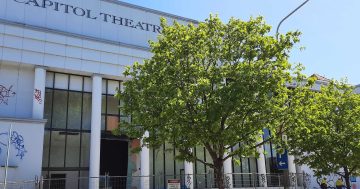
The Capitol Hotel and cinema complex construction site. Little room for a main entrance. Photo: Michelle Kroll.
As the first stage of the Liangis Group’s hotel and cinema development in Manuka rises to its full commanding height and people start to get an idea of how the former premium shopping and restaurant precinct could be reborn, the planning authority has thrown a spanner in the works.
It has approved the project’s bigger second stage but is demanding that it include a central entrance with a porte-cochère, a fancy name for a covered entry for vehicles, on the Manuka Circle/Canberra Avenue frontage that befits what the National Capital Authority calls a grand boulevarde.
The National Capital Design Review Panel also wants a pedestrian link or arcade through the centre of the development, connecting Franklin Street and Manuka Circle and on to Manuka Oval and Telopea Park.
Because the development is on one of Canberra’s major avenues, it comes under the watch of the National Capital Plan.
The proponent has already had to change the design so it is less Parisian and more Federal Capital in look, but despite that, Stage 1’s elegant curves on the gateway corner of Franklin Street and Flinders Way and Manuka Circle is showing what is possible when developers look beyond the brutal geometry of modernism.
But family matriarch Sotiria Liangas is putting her foot down about the entrance condition despite the planning authority rejecting the proponent’s Reconsideration application.
There will “never” be a Canberra Avenue entrance, she declared.
The impasse is not good news for Manuka’s struggling businesses, which have already seen the precinct’s decline before the pandemic hit.
The redevelopment of the nearby former public housing sites and now the Capitol Theatre building pointed to a Manuka renaissance that has been eagerly awaited.
But the revitalisation that a five-star hotel, cinemas, shops and restaurants will bring is now at risk because the planners want to retrofit Canberra Avenue.
There are very good practical reasons why a Canberra Avenue entrance is not a good idea.
Not only would it be dangerously close to the road, but it would pose immense traffic management problems.

An artist’s impression of the project. Images: Stewart Architecture.
There will be access from Canberra Avenue to underground parking, but the kind of grand entrance sought will introduce a major congestion point in an already busy area from the Captain Cook Crescent traffic lights that includes a service station, Flinders Way, Furneaux Street and the next set of lights near the cathedral for the pedestrian crossing to Manuka Oval.
Canberra Avenue is a busy four-lane arterial road that carries cars, trucks and buses. Who will want to sit in a cafe or bar and watch the traffic go by or the gridlock that would emerge?
Activating that frontage will be an impossible task when the life of Manuka will be in Franklin Street, away from the heavy traffic where the main entrance is planned.
There will also be entrances opposite the cathedral and on Flinders Way, close to the two public car parks.
As Mrs Liangis says, the entrances will be where the people are.

Another view of the project.
The notion of a pedestrian link is also misguided. Unless another crossing is envisaged, people walking to and from Manuka Oval can use the existing crossings and walk into and out of Manuka via Captain Cook Crescent, Flinders Way and Furneaux Streets.
A central arcade will not provide a shorter or more direct journey and in any case, would you want a well-sauced mob marching through the middle of your sparkling new building?
The Liangis Group is pouring millions into a landmark development to restore Manuka’s fortunes as a retail and entertainment precinct that will serve not only the inner south but the many Canberrans and interstate visitors who will visit.
A single tree that sprouted between buildings and fed on sewage delayed the project once. It does not need another potentially greater delay because of an outdated and impractical planning notion.














